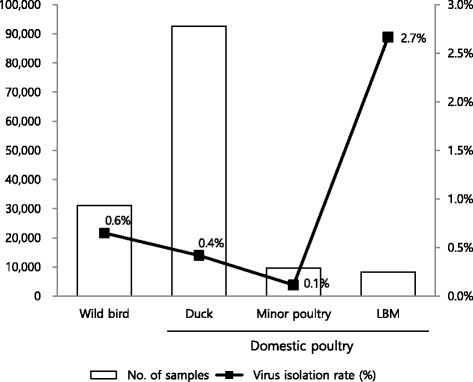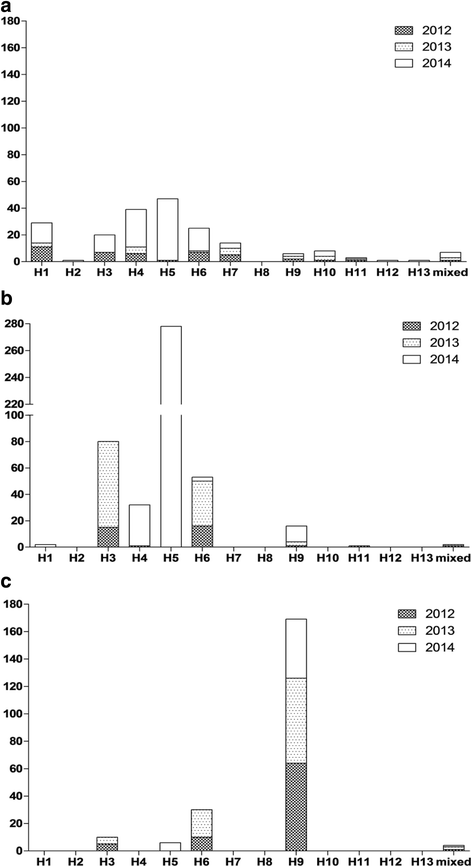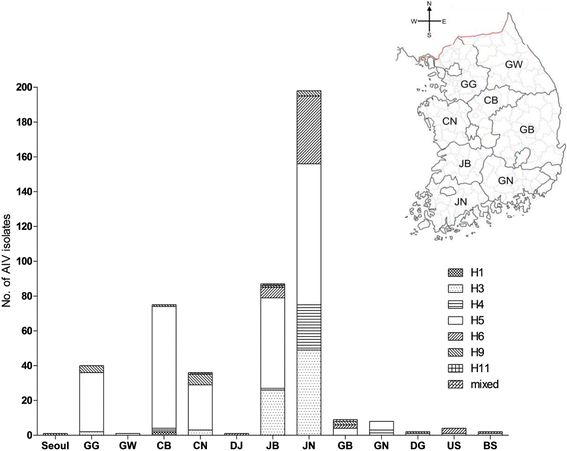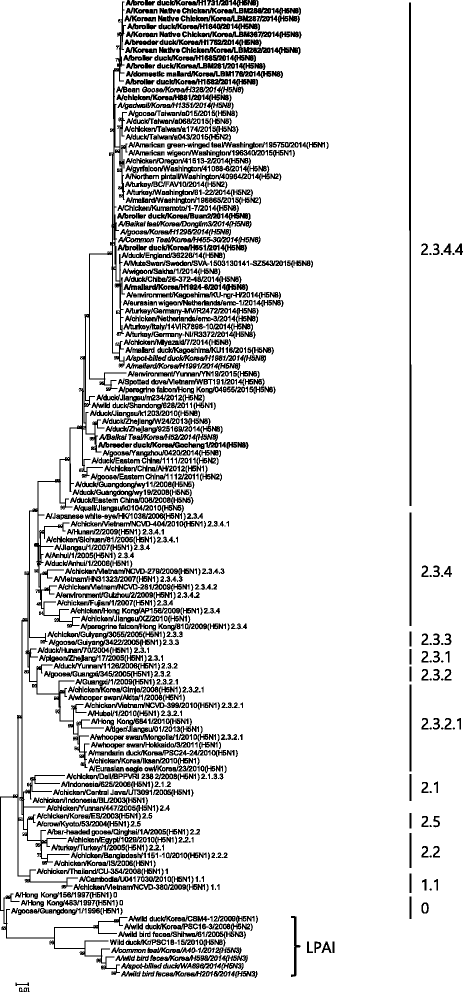Surveillance of avian influenza viruses in South Korea between 2012 and 2014
- PMID: 28292308
- PMCID: PMC5351195
- DOI: 10.1186/s12985-017-0711-y
Surveillance of avian influenza viruses in South Korea between 2012 and 2014
Abstract
Background: National surveillance of avian influenza virus (AIV) in South Korea has been annually conducted for the early detection of AIV and responses to the introduction of highly pathogenic avian influenza (HPAI) virus. In this study, we report on a nationwide surveillance study of AIV in domestic poultry and wild birds in South Korea between 2012 and 2014.
Methods: During the surveillance programs between 2012 and 2014, 141,560 samples were collected. Of these, 102,199 were from poultry farms, 8215 were from LBMs, and 31,146 were from wild bird habitats. The virus isolation was performed by inoculation of embryonated chicken eggs and AIV isolates were detected using hemagglutination assay. For subtying of AIV, the hemagglutinin and neuraminidase genes were confirmed by sequencing. Phylogenetic analysis of the H5 subtypes was performed using 28 H5 AIV isolates.
Results: Between 2012 and 2014, a total of 819 AIV were isolated from 141,560 samples. Virus isolation rates for AIV were 0.6, 0.4, 0.1, and 2.7% in wild birds (n = 202), domestic ducks (n = 387), minor poultry (n = 11), and the live bird market (LBM) (n = 219), respectively. In wild birds, various subtypes were found including H1-H7 and H9-H13. The major subtypes were H5 (n = 48, 23.9%: N3 (n = 4) and N8 (n = 44)), H4 (n = 39, 19.4%), and H1 (n = 29, 14.4%). In domestic poultry, mainly ducks, the H5N8 (n = 275, 59.3%), H3 (n = 30, 17.2%), and H6 (n = 53, 11.4%) subtypes were predominantly found. The most frequently detected subtypes in LBM, primarily Korean native chicken, were H9 (n = 169, 77.2%). H3 (n = 10, 4%) and H6 (n = 30, 13.7%) were also isolated in LBM. Overall, the prevalence of AIV was found to be higher between winter and spring and in western parts of South Korea. The unusual high prevalence of the H5 subtype of AIV was due to the large scale outbreak of H5N8 HPAI in wild birds and domestic poultry in 2014.
Conclusions: Enhanced surveillance and application of effective control measures in wild birds and domestic poultry, including LBM, should be implemented to control AI and eradicate HPAI.
Keywords: Avian influenza virus; Domestic poultry; LBM; Surveillance; Wild bird.
Figures





Similar articles
-
Live bird markets in Bangladesh as a potentially important source for Avian Influenza Virus transmission.Prev Vet Med. 2018 Aug 1;156:22-27. doi: 10.1016/j.prevetmed.2018.05.003. Epub 2018 May 2. Prev Vet Med. 2018. PMID: 29891142
-
Isolation and Genetic Characterization of Avian Influenza Viruses Isolated from Wild Birds in the Azov-Black Sea Region of Ukraine (2001-2012).Avian Dis. 2016 May;60(1 Suppl):365-77. doi: 10.1637/11114-050115-Reg. Avian Dis. 2016. PMID: 27309081
-
Avian influenza virus subtypes inside and outside the live bird markets, 1993-2000: a spatial and temporal relationship.Avian Dis. 2002 Apr-Jun;46(2):298-307. doi: 10.1637/0005-2086(2002)046[0298:AIVSIA]2.0.CO;2. Avian Dis. 2002. PMID: 12061638
-
Avian influenza A viruses in birds --an ecological, ornithological and virological view.Dtsch Tierarztl Wochenschr. 2005 Dec;112(12):448-56. Dtsch Tierarztl Wochenschr. 2005. PMID: 16425630 Review.
-
An overview of the epidemiology of avian influenza.Vaccine. 2007 Jul 26;25(30):5637-44. doi: 10.1016/j.vaccine.2006.10.051. Epub 2006 Nov 9. Vaccine. 2007. PMID: 17126960 Review.
Cited by
-
Salmonella Gallinarum delivering M2eCD40L in protein and DNA formats acts as a bivalent vaccine against fowl typhoid and H9N2 infection in chickens.Vet Res. 2018 Oct 1;49(1):99. doi: 10.1186/s13567-018-0593-z. Vet Res. 2018. PMID: 30285855 Free PMC article.
-
Potential risk zones and climatic factors influencing the occurrence and persistence of avian influenza viruses in the environment of live bird markets in Bangladesh.One Health. 2023 Oct 13;17:100644. doi: 10.1016/j.onehlt.2023.100644. eCollection 2023 Dec. One Health. 2023. PMID: 38024265 Free PMC article.
-
Prevalence and risk factors for avian influenza virus (H5 and H9) contamination in peri-urban and rural live bird markets in Bangladesh.Front Public Health. 2023 Apr 20;11:1148994. doi: 10.3389/fpubh.2023.1148994. eCollection 2023. Front Public Health. 2023. PMID: 37151580 Free PMC article.
-
Epidemiology and molecular characterization of avian influenza A viruses H5N1 and H3N8 subtypes in poultry farms and live bird markets in Bangladesh.Sci Rep. 2023 May 16;13(1):7912. doi: 10.1038/s41598-023-33814-8. Sci Rep. 2023. PMID: 37193732 Free PMC article.
-
A literature review of the use of environmental sampling in the surveillance of avian influenza viruses.Transbound Emerg Dis. 2021 Jan;68(1):110-126. doi: 10.1111/tbed.13633. Epub 2020 Jul 11. Transbound Emerg Dis. 2021. PMID: 32652790 Free PMC article.
References
-
- Fouchier RA, Munster V, Wallensten A, Bestebroer TM, Herfst S, Smith D, Rimmelzwaan GF, Olsen B, Osterhaus AD. Characterization of a novel influenza A virus hemagglutinin subtype (H16) obtained from black-deaded gulls. J Virol. 2005;79:2814–22. doi: 10.1128/JVI.79.5.2814-2822.2005. - DOI - PMC - PubMed
-
- FAO. Global Animal Disease Information system. http://empres-i.fao.org. Accessed 2 Aug 2016.
-
- World Health Organization (WHO). http://www.who.int/influenza/human_animal_interface/EN_GIP_20160509cumul... = 1. Accessed 9 May 2016.
Publication types
MeSH terms
Substances
LinkOut - more resources
Full Text Sources
Other Literature Sources
Medical
Miscellaneous

